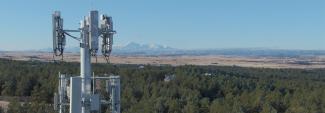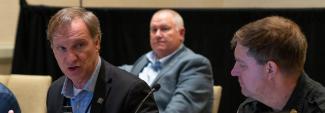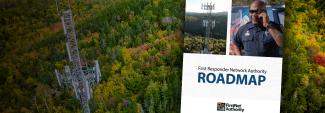Remarks by Edward Horowitz, FirstNet Authority Board Chair
Public Safety Communications Research (PSCR) Division
Public Safety Broadband Stakeholder Meeting
Chicago, IL, July 10, 2019
— As prepared for delivery —
Good morning, I am Edward Horowitz, Chair of the FirstNet Board.
First of all, Happy Birthday to the Sony Walkman — a product that still exists! The Walkman proves that when something works and becomes a cultural icon, it lasts a long time. It has been reinvented a couple of times from audio tape, to CD player, to MP3 player, to now a video and audio playout system. But it always stayed true to its roots as a personal portable entertainment system.
I am very pleased to be here to kick off today’s session — what a productive meeting it has been so far this week!
The invitation to address PSCR’s stakeholder meeting has become a time-honored tradition of sorts for the FirstNet Authority, and we appreciate this opportunity — thank you to Dereck and his team.
Every time anyone from FirstNet comes to address this group, we declare it an important moment in history. Our previous Board Chair, Sue Swenson, had the opportunity to keynote this event four times! Sue truly was a visionary — someone who believed strongly in the mission and potential of FirstNet to help our nation’s first responders. In fact, she was a founding member of the First Responder Network Authority.
In the audience today is Teri Takai, a founding, and longest serving board member who will be retiring from the Board in August after seven years. I want to thank her for her service.
Sue, Teri, and others set the bar high for all of us — and that includes you. My job, the job of the other Board Members, and the job of the FirstNet Authority staff is to keep the standards of performance high. To keep the mission in the forefront and require you to do the same thing.
Before talking more about FirstNet, I do want to spend a couple minutes discussing PSCR and the important role they have played to chart a path forward for public safety communications.
For more than 15 years now, PSCR has led the way for public safety communications research and development — blazing a trail before FirstNet. In the early days, they were leaders on narrowband issues, such as LMR standards development, and gathering public safety requirements.
As technology evolved, so did they. PSCR was at the forefront of engaging with public safety on network technologies to meet their mission needs — their “blue sky thinking” with public safety broadened from LMR to include broadband data.
As discussions about what would become FirstNet were underway, PSCR was a driving force behind getting priority and preemption features into products and solutions and working closely with industry.
And of course, the law that created FirstNet in 2012 provided research and development funding to PSCR to focus on future innovations for public safety and ways to spur next-generation technologies for first responders.
This included the creation of a roadmap in 2013, leveraging public safety input for key research areas. They are the basis of all the challenges and prizes and grant work ongoing today and what we are learning about this week.
So, I want to thank Dereck and the PSCR team for their effort and dedication — for continuing to be a driving force for public safety communications, and for bringing industry, academia, government, and public safety together to focus on the needs of our nation’s first responders.
More than ever before, there is a clearly defined marketplace for public safety communications, and PSCR is keeping us focused on the future — looking 5, 10,15 years out — so that we continue to innovate for public safety.
This work will ultimately save lives and keep our communities safe, but it also stands to revolutionize the way our nation’s first responders do business, as well as the business of being a first responder. It is not just about the technological art of the possible.
What is the return on investment?
Whether it be a function of weight, size, and power relative to the benefit of carrying another tool or device, or the dollars-to-benefit of the feature into a budget, this technology is making a difference for public safety and the communities they serve.
As more computer power is put into the hands of the end user, there are concerns about information security and patient privacy. How does that impact investment in data management? FirstNet is working hard to ensure first responders and the community can feel confident in the security of their data and personal information.
And at the FirstNet Authority, we need the input of PSCR’s work products to inform future innovations, and we are proud to be a partner with PSCR as we continue to transform public safety communications together.
As you may know, I’m new to the Board Chair position but not to the FirstNet Board — I joined in 2014.
On September 11, 2001, I was scheduled to attend a breakfast meeting on the 107th floor of Building One — the North Tower of the World Trade Center. The meeting outgrew the room’s capacity and was moved to Midtown — it was replaced by a Merrill Lynch breakfast, and a friend of mine, Michael Miller, never made it home that day.
So when the opportunity presented itself to get involved with building a network dedicated to public safety, I leaned into it.
I have spent virtually my entire career on building out communications environments, ranging from cable television, to taking MTV around the world, to empowering individuals to getting programming across borders via satellite, to bringing banking by internet and phone to the unbanked around the world, to where we are now assuring that public safety can seamlessly and reliably communicate with one another on a network dedicated to them.
FirstNet was a startup when I joined the Board — it is amazing to see the progress with the organization and the network, as well as the evolution of the public safety marketplace.
Now, we have a network up and running based on what public safety told us they needed, and it is making a difference in their lives and in the lives of the communities they serve:
- More than 40 apps have been identified in the FirstNet App Catalog;
- 75 dedicated deployables — like SatCOLTS and Flying Cell on Wings — are available;
- More than 100 devices are approved for use on the network through the NIST list maintained by PSCR, giving us the only certified network serving public safety;
- More than 7,250 public safety agencies have subscribed; and
- More than 600,000 connections are being used.
How did we get here in such a short period of time? Well, of course we wouldn’t be here without a lot of the work and dedication from the people in this room today — this truly is a shared mission, and the success of today would not be possible without the commitment to public safety that unites and brings all of us here today.
We have achieved many important milestones for public safety in the last five years. One of the things I am most proud of is the FirstNet Authority’s ability to develop a sustainable business model for the network.
The legislation gave us a mandate, cash, and spectrum. And our job was to make it work. And find a technology partner. And fast. Because public safety had waited too long.
So it is exciting to look back at the last five years and see us transform from a startup to a public-private partnership — one with the ability to direct investments back into the network for public safety. This is truly unique.
We are now in the next phase of FirstNet, focused on advancing the network and creating opportunities and partnerships across government, industry, and public safety, and with our partner AT&T.
At our Board meeting last month, we reviewed the vision, direction, and public safety input for our Roadmap — a living plan for the future of the network.
To gather input for the Roadmap, we conducted more than 600 engagements involving over 15,000 public safety representatives in 2019.
The FirstNet Authority also conducted targeted industry engagements and market research to capture technology trends.
We are building the Roadmap around six technology domains that reflect the most important communications capabilities for public safety’s mission, as told to us by public safety.
As I outline these areas and share our vision for each, I want you to think about how you can contribute. Our vision for this roadmap is to create opportunities and new lines of business for the entire public safety ecosystem — federal agencies, industry, local public safety, and others:
- The FirstNet network Core: We want to ensure the network is technologically current and supports the mission-critical features and capabilities that public safety needs. This means we must continue to evolve and enhance the FirstNet Core for public safety and ensure parity with innovation in the commercial marketplace. We need to ensure the network will be 5G ready and beyond, evolving with technology throughout the life of our 25-year contract and more.
- Coverage and capacity: We want to make the network available to public safety when and where they need it. This can be macro coverage and capacity, as well as on-demand solutions like the FirstNet-dedicated deployables or in-building coverage. Again this is evolving and advancing the actual buildout of the network to continue to meet public safety’s needs.
While these two domains are concerned with the foundational elements of the network, the other four align to technologies and capabilities that will enable first responders to take full advantage of FirstNet’s functions and features.
What you will see is that there are many synergies with PSCR’s own research areas:
- Situational awareness: Our vision is to provide real-time access, collection, and distribution of threats, hazards, and conditions tailored to public safety operations. This includes location-based services, sensors, wearables, video, mapping, data analytics, and artificial intelligence.
- Voice communications: We want to leverage all available voice-related technologies to ensure the most advanced features are available, including push-to-talk and internetworking with LMR.
- Secure information exchange: The vision for this domain is to enable secure, reliable, and easy-to-use access and sharing of critical information across a variety of sources. This is cybersecurity and protections and facilitating functions like ICAM.
- User experience: We want to create an experience on the network driven by public safety operational needs that allows users to focus on their primary mission. This includes augmented reality, hands-free displays, and heads-up displays, as well as devices and accessories to meet their needs.
As I said before, this will be a living plan — it will be updated regularly and help shape our investments. But it is a marathon, not a sprint. We remind ourselves of that every day.
One of the hallmarks of the FirstNet Authority is that we are laser focused and able to move quickly from one milestone to the next. You saw this with initial consultations, the RFP [Request for Proposal], state plans, and the network buildout.
All ahead of schedule. And we have pledged to continue the pace in this next phase of FirstNet.
After we release the Roadmap, we will look to make decisions on initial investments as soon as possible — to keep progressing forward, to ready the network for the future, and to make good on our commitment to public safety.
But I want to be very clear — it is important to understand that the Roadmap is more than investments. It also will guide the FirstNet Authority’s activities and programs beyond investment dollars — including our partnerships with all of the communities represented in this room today, including PSCR.
As we have learned throughout the course of public safety communications, success is achieved only when you:
- Prioritize the public safety mission;
- Evolve with technology and public safety’s needs; and
- Partner with stakeholders.
That has been our formula for success at the FirstNet Authority and will continue to be our mantra going forward. That is why collaborations like the ones PSCR is building are so critical.
PSCR’s Tech to Protect Challenge to drive the development of apps for first responders is a groundbreaking nationwide project — coming to 10 cities across the country. It is going to draw on the complete ingenuity of the American tech community and push the boundaries of creating new solutions to help public safety protect the public.
Tech to Protect further demonstrates the close collaboration between PSCR and the FirstNet Authority and is a model for future work between us.
We have technical leads from our staff helping to develop four of the ten challenges:
- Using augmented reality to show vehicle schematics. A firefighter shows up on an accident scene involving an electric vehicle, how do you know where you can cut without electrocuting oneself?
- Voice commands to virtual assistants
- Sensor integration — monitoring emergency responders’ health. What is necessary to measure, and to what end?
- Organizing chaos: calming catastrophe by tracking patient triage. This challenge would create an electronic patient tag that would also monitor a patient’s vital signs for sudden change.
This is cutting edge for public safety. And as it happens, these challenges focus on the “boot-on-the-ground” needs of public safety and would fall under the Situational Awareness domain of our Roadmap.
The FirstNet Authority is very pleased to be partnering with PSCR on Tech to Protect, and I know you all will hear more at the next session on the great things in store.
PSCR also is driving forward on two other open challenges. In fact, if you were here yesterday you might have caught the Haptics demo like I did.
In keeping with the Challenge Theme — I’m here to offer a challenge to everyone here. Do not let up — keep pushing the art of what’s possible for public safety.
Technology itself is not a strategy. We must be careful not to become too attached to a specific technology. Instead, look at the end goal — in this case, public safety.
We must look at how to use technologies to make public safety’s job more efficient and effective — not necessarily easier, because it is never easy.
But how can it help them — and it’s important that public safety’s feedback continues to be central to this effort.
For example, for EMS to bring the power of the emergency room and the doctor into the patient’s home, what do paramedics, EMTs, nurses, and doctors need? What do they need to efficiently and effectively deliver care and improve patient outcomes?
Some of this is beyond PSCR and FirstNet — for example there might be changes needed to business practices or training. But technologies have an important role to play, and that is my challenge to you — find the opportunities and make it possible.
When I look back at the last five years of my time at FirstNet, I am amazed at the progress made, not just in the deployment of this network, which will enable technology, but of the work of the stakeholders in this room, and what we can achieve when working together for a common goal.
You are paving the way for advancements that will transform public safety operations. That will ultimately protect communities and save lives.
Thank you.




















